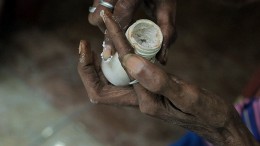Mata Panas
Photo essay – Sunday afternoon in the village of Suli, Ambon Island. A mother with her child visiting a healer. This is a ritual healing of an infant who has been attacked by a so called suanggi. A suanggi is said to be a sorcerer or witch using evil magic.
People believe that a suanggi drinks the blood or eats the internal organs of their victims and fill their victims bodies with leaves and grass. In the village community, it’s said that infants are easy targets for a suanggi. Eventually, it is believed that they devour an infant’s soul. This social phenomenon is also known as mata panas, literally it means hot eyes. In the social context of the village, it refers to the evil eye of a male or a female witch who is seeking for an infant to feed him or herself. If an infant has a swollen abdomen and hot eyes it seems to be attacked by a suanggi.
The child in this photo essay was mysteriously ill and considered to have been attacked. The man, ‘uncle’ Paul (in the village he considered to be a healer, someone who has certain knowledge about local costumary practices), is healing the child with a certain cleansing ritual. He is performing it through Christian prayers and using betel nut* in a traditional way. The betel mixture in his mouth he spits on the buttocks of the child. This particular healing ritual takes place according to certain acts that are derived from Christianity and customary law, the adat. Typical expressions of religious syncretism which are complementary to such matters, concerning religion and the invisible ancestral world. [July 2014]
*The specific ingredients to chew betel. The betel nut [ in Malay language: pinang], lime spatulas [kapur sirih] and betel leaves [daun pinang]. This stimulant is a mixture of areca palm nuts and leaves from the betel, a climbing plant. All these ingredients together are wrapped in betel leaves and chewed into a fine substance. The betel quid is used during ceremonies, for ritual purposes or in situations to make a connection with the ancestral world. Sometimes people use slightly different ingredients that go along with chewing betel nut.
Side note: During conversations in the village I noticed that it is still taboo to talk about ‘mata panas’. Most people don’t talk about these cases of spirit possession. If it occurs people accuse ‘someone’ [often an elderly] to be a ‘Suanggi’. Also important to know is that ‘Mata Panas’ has different nuances, it depends from which perspective is spoken. In this case, it is a form of spirit possession among children.








